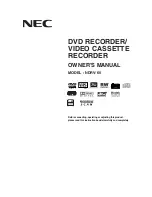
Chapter 5
Shot Mark Function
Chapter 5
Shot Mark Function
5-1
This unit allows the use of shot marks. Shot marks are
indications at desired points on a tape which enable
faster cuing.
Types of shot mark
On this unit, you can write post marks by a button
operation during playback, while stopped, or during a
search. It is possible to modify or erase the post marks.
This chapter describes the use of shot marks including
post marks.
First, the shot mark functions of this unit are described
in simple terms.
Reading shot marks
This unit reads in shot marks written on a tape and
stores them in memory (to a maximum of 200).
Once this data is stored in this unit, it is preserved even
when the power is turned off.
Writing and erasing shot marks
Post marks can be written at any point on a tape, and
also erased or rewritten.
5-1 Overview
Chapter 5
Shot Mark Function
Shot mark list operations
On the monitor, you can display a list of the shot
marks read in by this unit, select required shot marks,
delete shot marks, and so on. You can also add a
memo mark (#) to a shot mark in the list.
During tape playback, you can add virtual shot marks
to the list. This is not written on the tape itself.
Cuing up to shot marks
By selecting a desired shot mark from the shot mark
list, you can cue up immediately to that position. By
means of a button operation, you can also cue up to the
shot marks adjacent to the current tape position (index
function).
Shot data display
When the tape includes shot data (camera, time, and
other information captured at the time of shooting),
you can read this in, and display the details on a
monitor. It is also possible to display the shot mark list
and shot data simultaneously.
Sorting shot marks by cassette
When the tape includes shot data, this unit recognizes
which cassette each shot mark comes from. You can
therefore sort the read-in shot marks by cassette in
time code order.















































